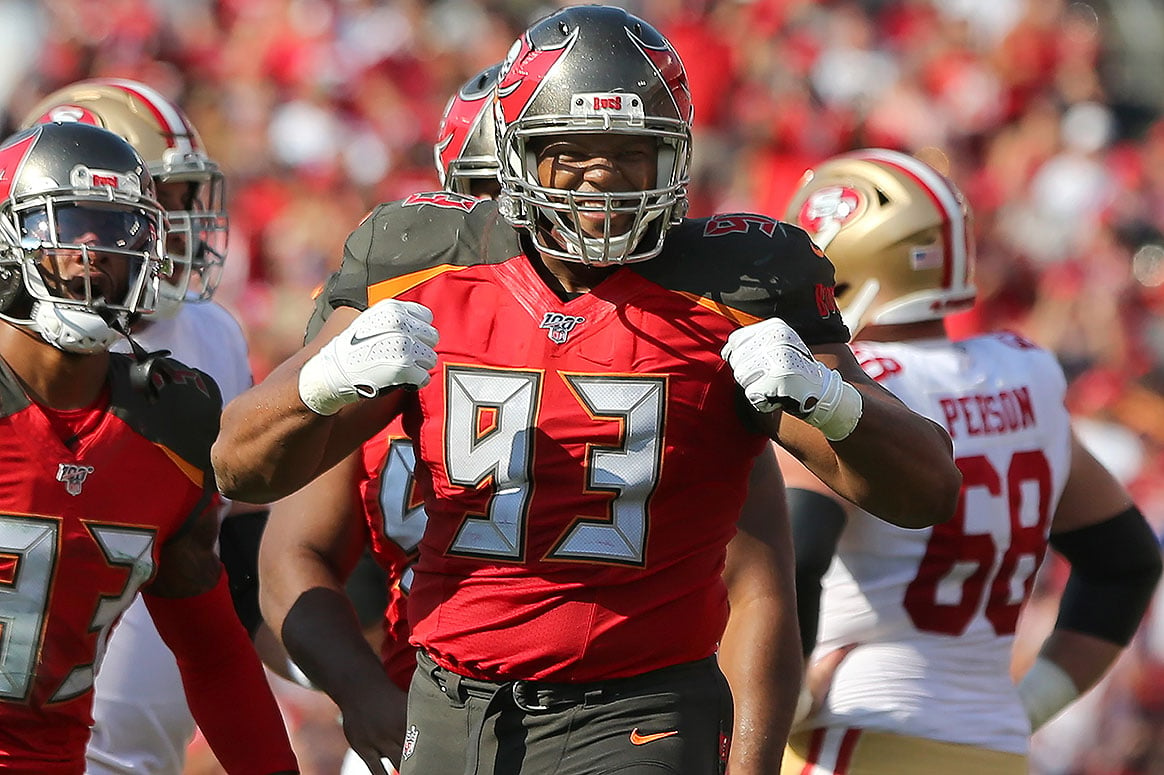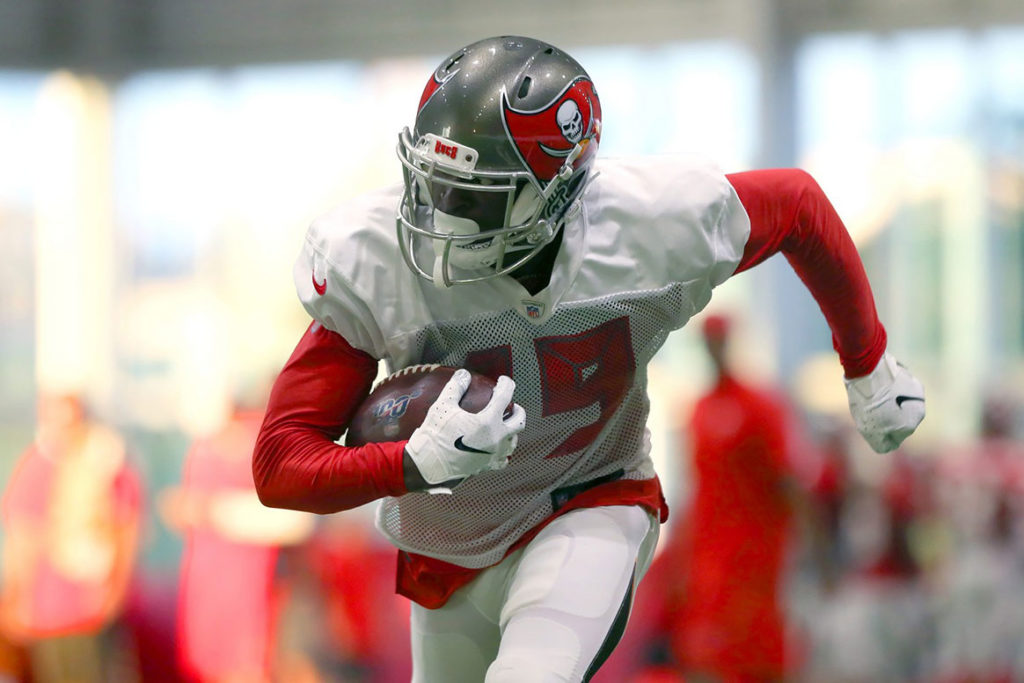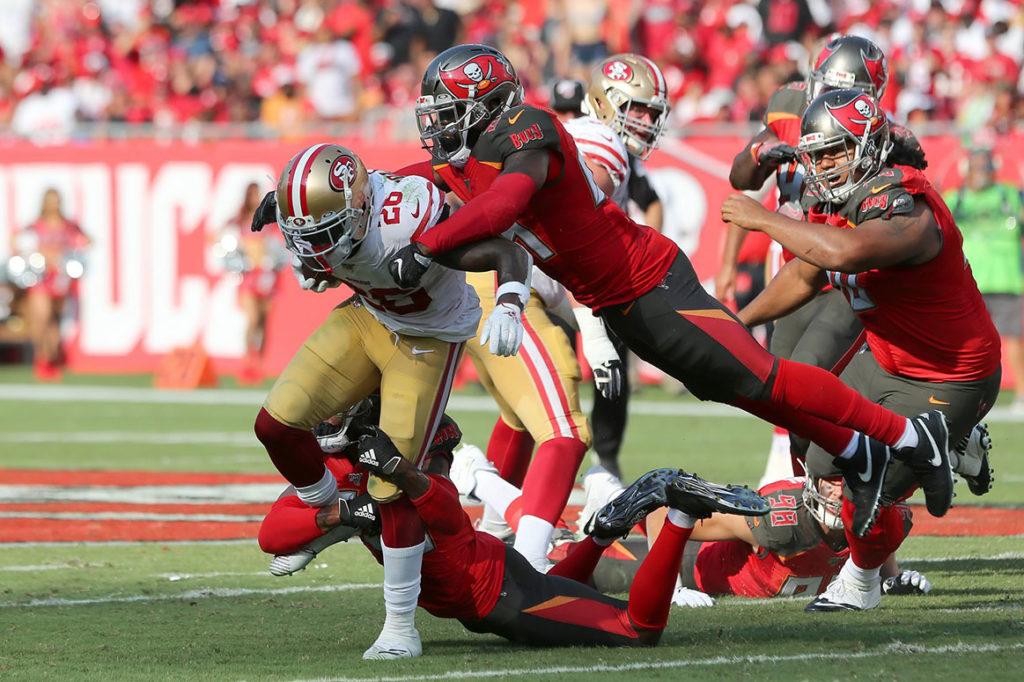FAB 2. These Bucs Are Built To Stop The Run
New Tampa Bay defensive coordinator Todd Bowles’ defense is built to stop the run.
That’s welcome news for any Buccaneers defenders that tried to stop the run last year in Mike Smith’s system. Those players saw New York Giants rookie Saquon Barkley rush for 142 yards and two touchdowns on 27 carries, while averaging 5.3 yards per carry.
They saw Cincinnati’s Joe Mixon rush for 123 yards and two touchdowns while averaging 5.9 yards per carry. Carolina’s Christian McCaffrey totaled 185 yards and two touchdowns on the ground in both games against Tampa Bay last year, while averaging a gaudy 6.9 yards per carry average. New Orleans’ Alvin Kamara only rushed for 80 yards and two touchdowns on 20 carries in two games, but Kamara also had 148 receiving yards and a touchdown on 14 catches against Tampa Bay.
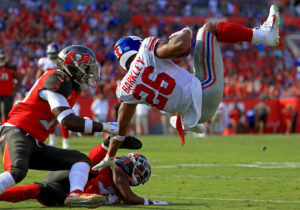
Giants RB Saquon Barkley – Photo by: Getty Images
This year, it’s been an entirely different story as Tampa Bay has the league’s No. 1 rushing defense, allowing just 59.2 yards per game on the ground through the first four weeks of the season.
Here are the top four running backs the Bucs have faced this season and the yardage those rushers have been held to:
49ers RB Matt Breida – 37 yards on 15 carries (2.5 avg.) with 0 TDs
Panthers RB Christian McCaffrey – 37 yards on 16 carries (2.3 avg.) with 0 TDs
NY Giants RB Saquon Barkley – 10 yards on eight carries (1.3 avg.) with 0 TDs
LA Rams RB Todd Gurley – 16 yards on five carries (3.2 avg.) with 2 TDs
Up next is New Orleans’ Pro Bowl rusher Alvin Kamara, who has rushed for 280 yards and a touchdown on 59 carries (4.7 avg.) with 20 catches for 199 yards (9.9 avg.) and one score in the passing game. With long-time Saints running back Mark Ingram gone to Baltimore via free agency, Kamara’s workload has increased, especially as a between-the-tackles rusher.
“Yeah, I think with Ingram gone,” Bucs head coach Bruce Arians said. “That’s what he did at Tennessee. This guy’s a hell of a back. This is four [strong running backs] in a row, but he is indeed different at jet sweeps and the way Sean [Payton] using him to get him in space. He’s probably the most dangerous receiver of the group of running backs that we’ve played so far, as far as angle routes going to the house, matchups on backers and safeties – he’s a legitimate threat, like McCaffrey.”

Saints RB Alvin Kamara – Photo by: Getty Images
New Orleans is averaging 102.5 yards per game, which ranks 19th in the league. Will the Saints not even try to run the ball and attack the Bucs’ young secondary through the air like the Los Angeles Rams did last week?
The fact that the Rams only ran the ball 11 times, including five with Gurley, for a total of 28 yards was likely a product of Tampa Bay having an early 21-0 lead, but shocking nonetheless.
“I’m not sure what they were thinking or what their game plan was, but they sure went away from the run quickly,” Bucs inside linebacker Kevin Minter said. “You would like to say they respect our run defense, but they are explosive in the passing game. We are establishing some respect around the league because we are pretty stout against the run defensively.”
If the Bucs were to keep up this torrid pace against the run all season then Tampa Bay would allow just 947 yards on the ground during the 2019 campaign, which would easily be a franchise record. Even some of Tampa Bay’s best all-time defenses haven’t been able to limit teams to less than 1,000 yards on the ground over an entire season.
1999 Buccaneers – ranked 5th in run defense – 1,407 rushing yards allowed
2002 Buccaneers – ranked 5th in run defense – 1554 rushing yards allowed
2005 Buccaneers – ranked 6th in run defense – 1,515 rushing yards allowed
Having the league’s top-ranked run defense doesn’t always mean that a team has a good defense. In 2012 during Greg Schiano’s first season as head coach in Tampa Bay, the Bucs had the top-ranked run defense, allowing just 1,320 yards (82.5 ypg) over the course of a season.
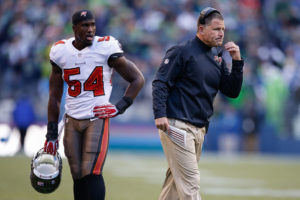
Bucs LB Lavonte David and former coach Greg Schiano – Photo by: Getty Images
But Tampa Bay’s opponents didn’t even try to run the ball that year, instead attacking the Bucs’ secondary, which was ranked dead last in the league, surrendering 4,758 (297.4) yards that year. That was the most passing yards ever allowed in an NFL season until the New York Giants surrendered 4,783 passing yards in 2015. Schiano’s 2012 defense ranked 29th in yards (379.9 avg.) and 23rd in points (24.6 avg.) that year, which wasn’t good.
The Bucs currently rank 21st in total defense (377.5 avg.) and 30th in points (29.2 avg.), but that statistic is inflated due to three pick-sixes by quarterback Jameis Winston. Tampa Bay’s pass defense is ranked 31st in the league (318.2 avg.) after allowing Rams quarterback Jared Goff to complete 45-of-68 passes for 517 yards with two touchdowns and three interceptions.
“I think Sean McVay made a choice that he was going to throw the ball and not try to run it, which, having played them in the past, it’s a little bit different,” Arians said. “To throw it 70 times or whatever it was – I’ve never seen it, I’ve never lost to it and it was a lot of yards. It’s a conscious decision.”
Tampa Bay’s pass defense is on a collision course for the record books in a dubious way – on pace to allow 5,091 passing yards this year, which would shatter the Giants’ record. The Bucs defensive backs have been picked on in recent weeks, especially after Tampa Bay’s offense jumped out to early 18-point and 21-point leads against New York and Los Angeles, respectively.
But cornerback Vernon Hargreaves III isn’t worried, and notes how Goff threw three interceptions and lost a fumble on a Shaq Barrett sack that turned into a Tampa Bay touchdown.
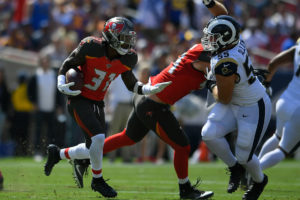
Bucs SS Jordan Whitehead – Photo by: Getty Images
“They have to be right every time they throw the ball,” Hargreaves said. “We have to be right only once and we can force an incompletion or get a turnover. We definitely want to make quarterbacks throw the ball on us because you can see what happened last week. Make the QB make a read and earn his money and we’ll see how it goes from there.”
Hargreaves is talking about the old football adage that five things can happen when a team throws the ball – a completion, an incompletion, an interception, a sack or a penalty – and usually only one or two of those things are good for the offense.
“That’s huge for us,” Hargreaves said. “Coach Bowles doesn’t play that – you aren’t going to run the ball on us. He’s not having it. We take pride in that, especially the defensive front seven. They know what’s coming. They know what to do. They know their gaps. They’re all smart, and they play from the neck up. And they all play together. We have a coach who emphasizes shutting down the running game, so it’s going to be tough for teams to run on us this year.”
Although the recent emphasis has been put on the passing game in the NFL due to rule changes that favor throwing the ball, it still makes sense for teams to want to establish the run first on offense and stop the run first on defense.
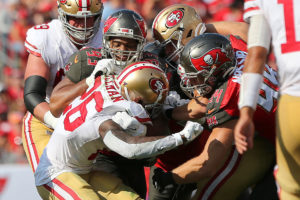
Bucs DT Ndamukong Suh and OLB Carl Nassib – Photo by: Cliff Welch/PR
“When offensive coordinators get cautious of calling run plays and they end up in third-and-long situations because they can’t run, it really limits the play-calling,” Bucs guard Ali Marpet said. “It lets the defense pin its ears back and control the game and do what it wants to do.”
Fellow guard Alex Cappa agreed with Marpet’s assessment, and looked at it from the Buccaneers’ offensive perspective.
“When you’re able to run the ball and run it multiple consecutive times, it’s a good thing, and we think we can get even better, too,” Cappa said. “It’s hard when you can’t run the ball like last year. When you can run it and establish a running game, it makes everything easier. You can use play-action and not have to drop back as many times. It definitely gives you confidence as a lineman when you can run the ball. It makes pass protection easier too, because we can wear down defensive linemen.”
Bucs inside linebacker Lavonte David said that the Rams didn’t even test Tampa Bay’s run defense last week.
“That’s true – they didn’t even try to run it against us,” David said. “It was a sign of respect. When you are playing the Rams, the main thing is to stop Todd Gurley. That’s what we tried to do. It worked. They did have a great day in the passing game throwing the ball 68 times, but also with a lot of turnovers. We’ll take that anytime. You want to make teams one-dimensional because everybody wants to establish the run. Once we got that out of the way we could dictate what we wanted them to do.”
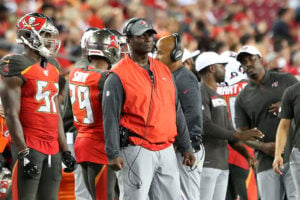
Bucs DC Todd Bowles – Photo by: Cliff Welch/PR
Because the Saints won’t have Brees this week, he knows Payton will favor a more balanced offense with a healthy dose of Kamara running the ball to take some of the pressure off Bridgewater. Arians signaled that Bowles’ Bucs run defense will be ready and waiting.
“We’ve [played against] three really good backs that I don’t think have 100 yards total between them,” Arians said. “We’re built to run and stop the run, and then get after the quarterback and take shots. That’s our M.O. and we’re not changing.”
Scott Reynolds is in his 30th year of covering the Tampa Bay Buccaneers as the vice president, publisher and senior Bucs beat writer for PewterReport.com. Author of the popular SR's Fab 5 column on Fridays, Reynolds oversees web development and forges marketing partnerships for PewterReport.com in addition to his editorial duties. A graduate of Kansas State University in 1995, Reynolds spent six years giving back to the community as the defensive coordinator/defensive line coach for his sons' Pop Warner team, the South Pasco Predators. Reynolds can be reached at: [email protected]

